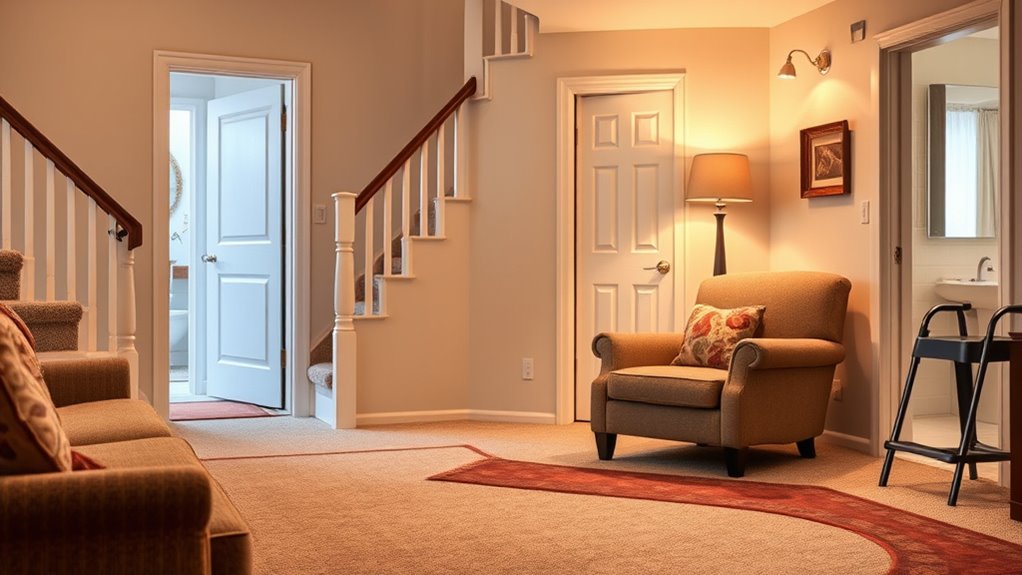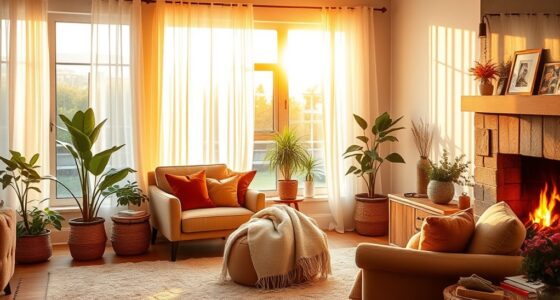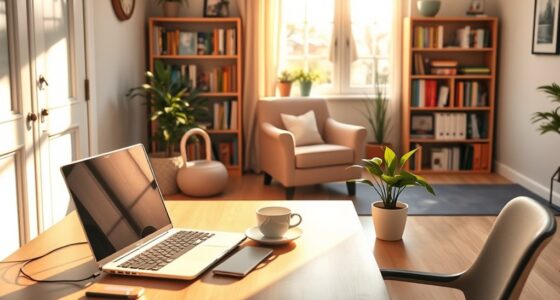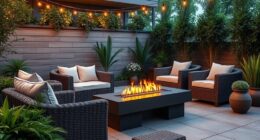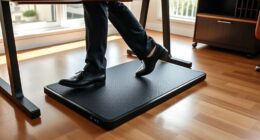To make your home elder-friendly, start by checking for hazards like overloaded outlets, damaged wiring, and loose rugs. Install grab bars, widen doorways, and add ramps for easier mobility. Improve lighting with smart systems and use contrasting colors to spot hazards easily. Incorporate supportive devices like emergency alarms and voice-activated controls. Focus on creating a safe, comfortable environment that promotes independence—there’s more to learn about creating a safer home for seniors.
Key Takeaways
- Remove tripping hazards, install grab bars, and widen doorways to enhance mobility and prevent falls.
- Ensure smoke detectors are functioning and keep fire hazards like overloaded outlets in check.
- Improve lighting with nightlights, smart systems, and contrasting colors to increase visibility and reduce accidents.
- Incorporate assistive devices such as emergency alarms, voice-activated controls, and motion sensors for safety.
- Maintain outdoor pathways, keep emergency kits accessible, and establish evacuation plans to support outdoor safety and preparedness.
Assessing and Identifying Potential Hazards in the Home
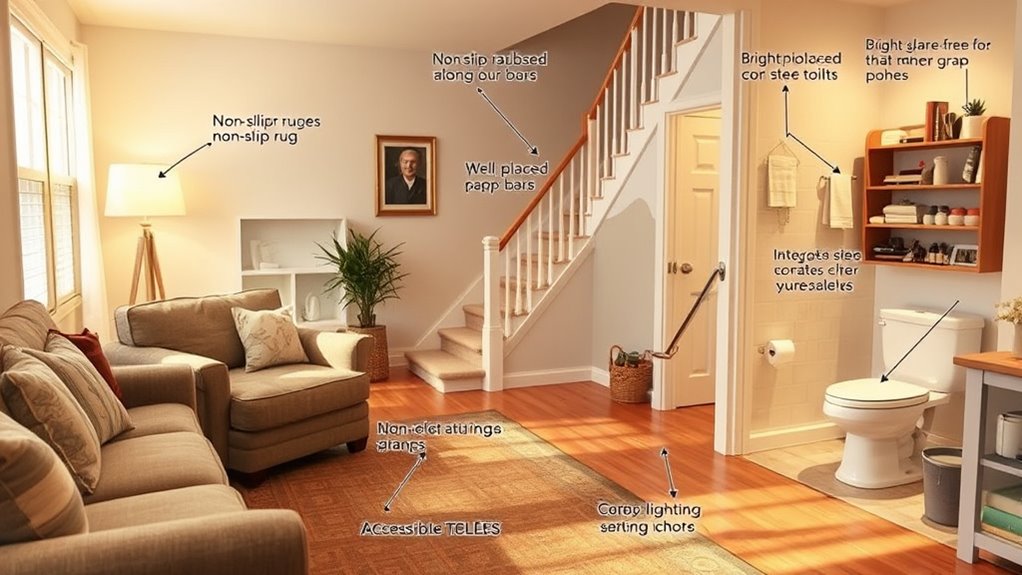
Before hazards can be addressed, it’s essential to thoroughly assess your home for potential dangers. Fire hazards are a common concern, so check for overloaded outlets, faulty wiring, and unattended flames from candles or stoves. Ensure your smoke detectors are working and replace batteries regularly. Electrical safety is equally important; inspect cords for wear, avoid running them under rugs, and keep outlets clear of clutter. Look for exposed wiring or damaged switches that could cause shocks or fires. Keep flammable materials away from heat sources, and consider installing surge protectors. Identifying these risks early helps prevent accidents and creates a safer environment. Taking the time to assess and address fire hazards and electrical safety is a vital step in safeguarding your home and loved ones. Additionally, understanding the importance of contrast ratio in your home’s lighting and visual safety can help prevent accidents and improve overall safety awareness. Proper lighting with balanced lighting contrast can reduce shadows and enhance visibility, further minimizing risks. Incorporating air purification technology can also improve indoor air quality, reducing allergens and respiratory risks that may affect vulnerable individuals. Moreover, evaluating your home’s ventilation system ensures good airflow, which is essential for maintaining a healthy living space for seniors. Regular ventilation checks can also help mitigate indoor air quality issues linked to pollutants and allergens.
Essential Modifications for Accessibility and Mobility
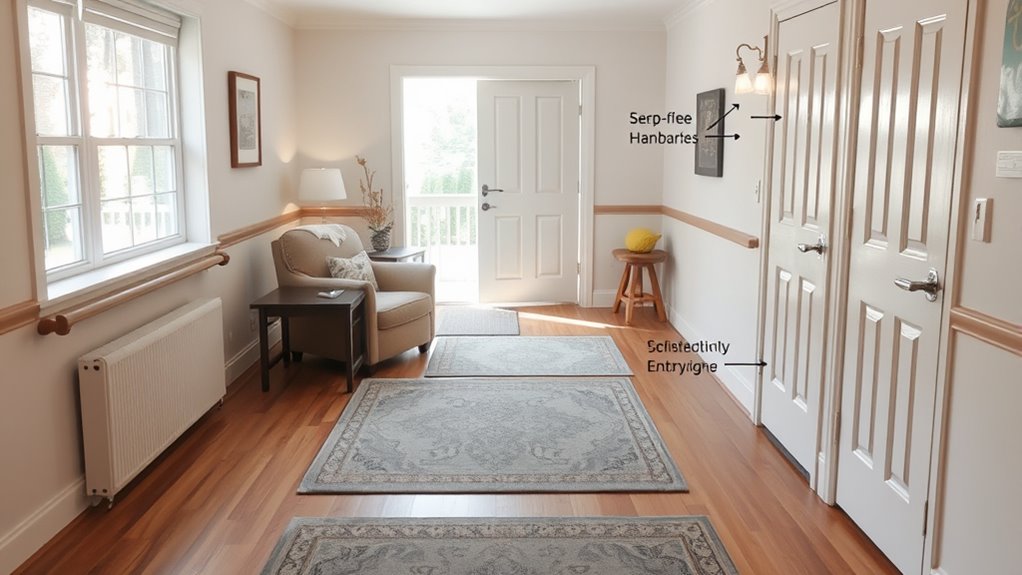
To guarantee your home remains safe and comfortable as mobility needs change, making essential modifications for accessibility is crucial. Start by removing tripping hazards like loose rugs and clutter to prevent falls. Install grab bars and handrails in the bathroom and along stairways to improve fall prevention and provide support. Widen doorways and hallways to accommodate mobility aids such as walkers or wheelchairs. Consider adding ramps at entry points to eliminate steps. These modifications also enhance emergency preparedness, enabling quick and safe exits during emergencies. Keep pathways clear and well-maintained to ensure easy navigation. Small adjustments can substantially boost safety, independence, and confidence, helping you stay secure and comfortable in your home as your mobility evolves. Understanding home safety upgrades can further assist in creating an elder-friendly environment.
Enhancing Lighting and Visual Cues for Better Safety
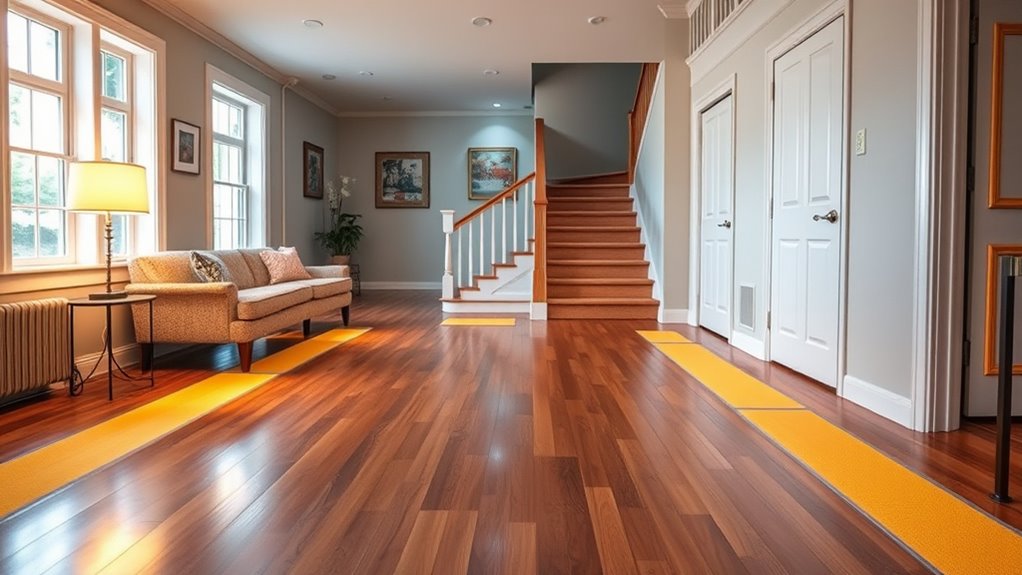
Improving lighting and visual cues is essential for reducing falls and enhancing safety in your home. Smart lighting systems allow you to automate bright, consistent illumination that adapts to your needs, especially at night. Visual cues, such as contrasting colors on stairs or doorframes, help you recognize hazards quickly. Proper lighting minimizes shadows and glare, making navigation easier. Use nightlights in bathrooms and hallways for added safety. Here’s a quick comparison:
| Feature | Benefit |
|---|---|
| Smart lighting | Automated, adjustable illumination for safety |
| Visual cues | Clear contrast enhances hazard recognition |
| Nightlights | Guiding light during nighttime |
| Contrasting colors | Improved visibility of stairs and edges |
| Consistent lighting | Reduced shadows and glare |
Additionally, selecting appropriate lighting can prevent accidents by ensuring all areas are well illuminated. Incorporating effective visual cues such as textured and marked surfaces can also help prevent missteps. For example, using color contrast on stair edges enhances visibility and reduces the risk of trips. Incorporating lighting design principles that focus on even distribution and glare reduction can further improve safety. Together, these strategies make your home safer and more senior-friendly. Incorporating attention to detail in your lighting setup can significantly improve overall safety and confidence during movement around the house.
Installing Supportive Devices and Assistive Technologies
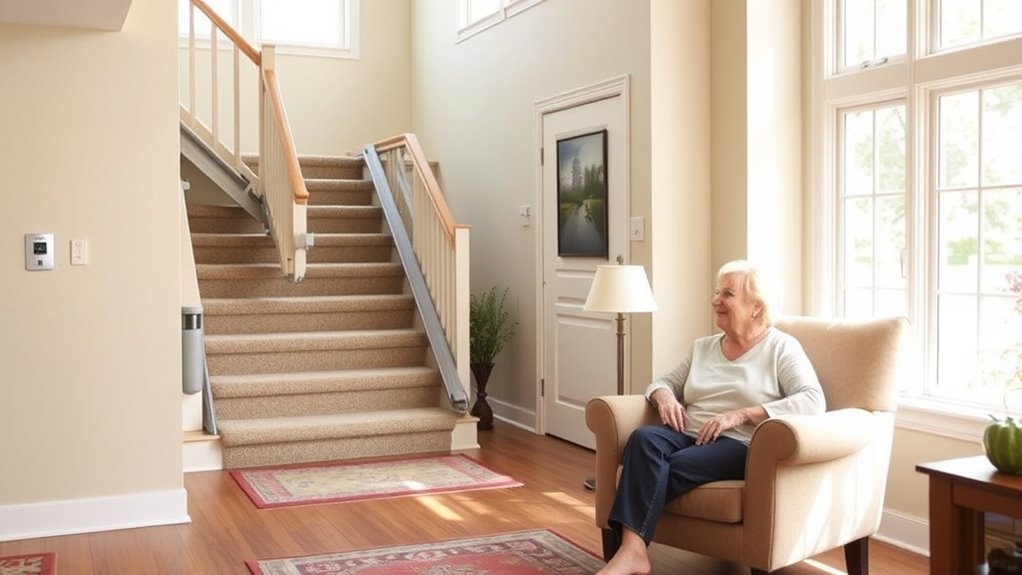
Installing supportive devices and assistive technologies can substantially enhance safety and independence in your home. A smart home system can automate lighting, control thermostats, and even monitor activity, making daily tasks easier and safer. Emergency alarms are essential; they provide immediate access to help if needed, giving you peace of mind. Consider voice-activated devices that allow you to call for assistance or operate appliances without physical effort. Motion sensors can alert you to movement in certain areas, preventing falls or intrusions. These technologies work together to create a safer environment, reducing hazards and supporting your autonomy. Additionally, some dog breeds are known for their friendly and loyal nature, which can be comforting companions for seniors. By integrating smart home features and emergency alarms, you’re taking proactive steps to maintain your well-being and confidence within your living space. Incorporating aesthetic wall organization can also improve visual interest and reduce clutter, contributing to a more comfortable and safe environment. Employing home safety assessments can identify specific risks and guide the installation of appropriate safety devices.
Creating a Comfortable and Supportive Environment for Wellness
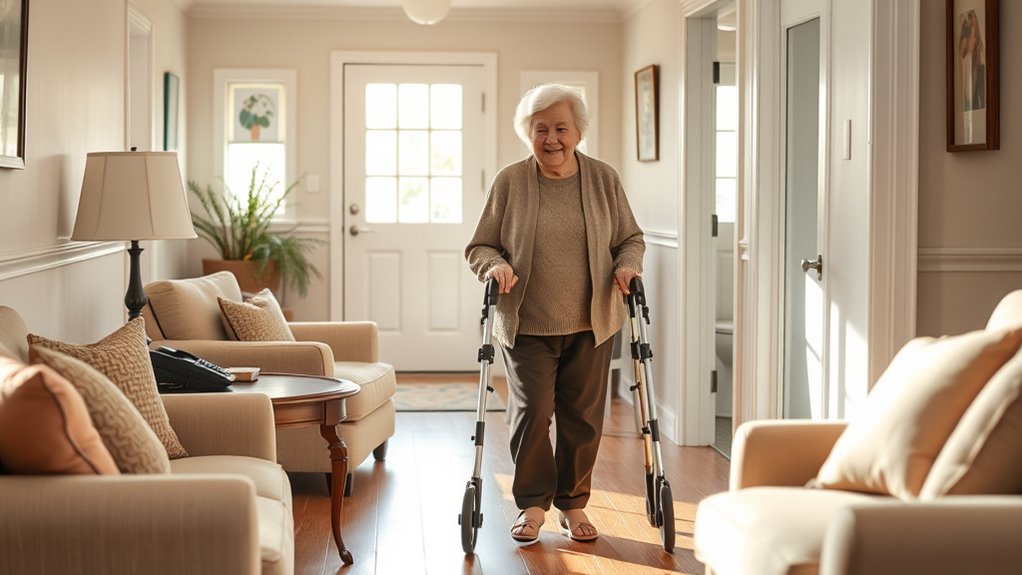
Have you considered how your home environment can support your overall wellness and comfort? Making your space safe and welcoming involves more than just support devices. Focus on garden safety by keeping walkways clear, installing sturdy handrails, and ensuring proper lighting. These steps help prevent falls and encourage outdoor activity, boosting your mental and physical health. Additionally, being prepared for emergencies creates peace of mind. Keep an accessible emergency kit nearby, and establish a plan for quick communication or evacuation if needed. A supportive environment combines safety and comfort, helping you feel secure and relaxed at home. Incorporating sound design techniques from trailer music can also enhance your home’s atmosphere, making it more calming and welcoming. By proactively addressing garden safety and emergency preparedness, you foster a space that promotes both wellness and independence.
Frequently Asked Questions
How Often Should Home Safety Assessments Be Updated for Seniors?
You should update your home safety assessments regularly, ideally every six months or after any significant changes. Conduct home inspections and safety audits more frequently if your senior loved one has health issues or mobility challenges. Regular reviews help identify hazards early, ensuring their environment remains safe. Staying proactive with these assessments protects your loved one and maintains their independence. Remember, consistent safety checks are key to a secure, elder-friendly home.
Are There Financial Assistance Programs Available for Home Modifications?
Did you know that many seniors face financial barriers to home modifications? You might qualify for various grant programs designed to help cover costs, and some insurance options may also provide coverage for safety upgrades. It’s worth exploring local government resources and nonprofit organizations that offer assistance. By taking advantage of these programs, you can make essential modifications without overspending, ensuring a safer home environment for your loved ones.
What Are the Best Practices for Maintaining Mental Health at Home for Seniors?
You should focus on engaging in mental health activities like puzzles, reading, or meditation to boost your well-being. Stay connected with loved ones for emotional support strategies, whether through calls or visits. Maintaining a routine, staying active, and practicing mindfulness can also improve your mood. Remember, prioritizing mental health at home helps you stay resilient and positive. Don’t hesitate to seek professional help if you need extra support.
How Can Technology Be Used to Monitor Senior Wellness Remotely?
Imagine having a watchful eye that never blinks—technology makes this possible. You can use remote monitoring and wearable devices to keep tabs on a senior’s health, activity levels, and essential signs from anywhere. These tools act as digital guardians, alerting loved ones or healthcare providers if something’s amiss. By embracing these innovations, you guarantee your loved ones stay safe and well, even when you’re miles apart.
What Are Common Legal Considerations When Making Home Modifications for Seniors?
When making home modifications for seniors, you need to consider legal compliance to ensure your changes meet local building codes and regulations. Liability concerns also come into play if someone gets injured due to unsafe modifications. You should document all work, obtain necessary permits, and hire licensed professionals when required. Doing so helps protect you legally and guarantees your home remains safe and accessible for your senior loved ones.
Conclusion
Just as a sturdy ship relies on strong anchors, your home becomes a safe haven through thoughtful modifications. By evaluating hazards, enhancing accessibility, and embracing supportive technologies, you create a haven where your loved ones can thrive. Like a well-tuned symphony, each change harmonizes safety and comfort, ensuring peace of mind. Remember, a proactive approach transforms your space into a sanctuary—where wellness blooms and hazards fade, leaving only the melody of security.

